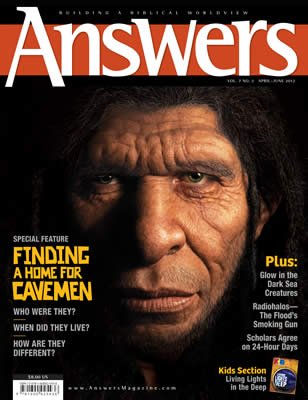
Neanderthals vs. Humans: Are They Different?
Finding a Home for Cavemen
Amazingly, scientists have recovered DNA from several Neanderthals and compared it to modern DNA. The differences are small but intriguing. What can we learn from the DNA about our early relatives?
New DNA technology has allowed scientists to peer into the past by mapping the DNA of so-called cavemen. And they have found some noticeable differences. So, what do those differences really mean—are those early people somehow less “human” than we are?
Before we can answer that question, we first need to understand two related issues. What can DNA tell us about the differences among people? And how does the biblical account of human origins shed light on these differences?
Differences in the DNA - Neanderthals vs. Humans
The ability to map DNA is an amazing feat, considering the DNA is thousands of years old! Many ancient human remains are found in equatorial regions where heat and humidity have destroyed the DNA. However, remains of the Neanderthals and another group of humans discovered in a cave in southern Siberia, the Denisovans, have been found in cold, dry, protected areas that better preserved the DNA.
Researchers concluded that it is 99.7% identical to modern human DNA.
When the first draft of Neanderthal DNA was published, the researchers concluded that it is 99.7% identical to modern human DNA. They also found that approximately 1–4% of DNA specific to Neanderthals can also be found in modern Eurasians. This led them to conclude that a very small number of Neanderthals mixed with early modern humans and produced children. Neanderthals had a wide geographic distribution in Eurasia, from Spain to southern Siberia, and from Germany to the Middle East, so it is not surprising that more of their DNA is found in modern Eurasians as opposed to other populations, such as Africans.1
To date, approximately eighty genes have been shown to differ between Neanderthals and modern humans.2
These genes produce proteins that govern a wide range of functions such as metabolism (how we burn food), the growth of the skull, and skin shade. Further study of these genes may help us understand how Neanderthals were different and perhaps why they died out.
For instance, one gene produces a protein involved in skin and hair color. Rare variants of this gene among modern humans lead to pale skin and red hair. The Neanderthal gene has a variation so far unknown in humans today. It is likely that this variant led to pale skin and red hair in Neanderthals.3 If this is so, Neanderthals would have been able to absorb more sunlight than if they had darker skin. This would have been useful in producing enough vitamin D to live healthy lives in the northern regions.
Denisovan DNA is also similar to DNA in modern humans. Approximately 4–6% of DNA that is specific to Denisovans can also be found in modern Melanesians (those who live in the islands northeast of Australia).4 As with the Neanderthals, this indicates that very few Denisovans mixed with and produced offspring with early modern humans—at least with those in Southeast Asia.5
Both Neanderthals and Denisovans do have small-scale differences with modern humans. Before the first draft of Neanderthal DNA, they were sometimes considered to be different human species or subspecies. But this is an arbitrary, manmade designation since two modern chimps of the same species will have more DNA variation than Neanderthals or Denisovans have to modern humans. In light of the genetic evidence, Neanderthals and Denisovans are fully human and should be classified as Homo sapiens.
Are the DNA Sequences Accurate?
Many difficulties must be overcome to accurately sequence ancient DNA. Sequencing DNA involves determining the correct order of the individual components (bases) that comprise the DNA. Contamination and degradation are two of the biggest obstacles.6 Contamination comes both from bacteria found in the fossil (which can sometimes account for more than 90% of the DNA found!) and from bacteria transferred through handling by modern humans. Degradation occurs when the DNA is “chopped up” and certain DNA components are modified by chemical reactions. Fortunately, scientists have developed techniques that greatly limit the danger of contamination and degradation altering the actual human DNA sequence, so their impact is usually negligible.
Another issue involves the limited number of ancient individuals with viable DNA. For example, there are only two known fossil remains for Denisovans from a single cave. At the most they represent two individuals. Compare that to the thousands of modern humans whose DNA has been sequenced. A small sampling of an ancient population may not truly reflect the full range of variety in that particular group. The Neanderthal samples, in contrast, come from over a dozen different individuals at sites on different continents, so they are much more likely to represent the population as a whole.
It is also important to acknowledge the many evolutionary assumptions that are made when comparing the DNA sequence of ancient individuals to modern humans.7 For example, a common human-chimp ancestor was assumed. One paper stated, “To estimate the DNA sequence divergence . . . between the genomes of Neanderthals and the reference human genome sequence . . . [we used] an inferred genome sequence of the common ancestor of humans and chimpanzees as a reference to avoid potential biases.”8 Apparently the authors of the paper don’t consider assumed human-chimp ancestry as a bias, but it is! Creation scientists are actively studying methods to avoid these biases so that more valid comparisons can be made.
A Biblical Perspective: Neanderthals vs. Humans
Genetics has clearly established that Neanderthals and Denisovans were fully human. Any physical differences should be viewed as nothing more than variations that can occur within the human race descended from Adam and Eve. For a time, these descendants all lived together at the Tower of Babel. Following the post-Babel migration and late into the Ice Age, differing human populations began to appear in the fossil record, such as Neanderthals and Denisovans.
The next questions for creationists are how and why these differences appeared.9 How is much easier to answer than why! One possibility is that environmental pressures, such as the Ice Age, “selected” for or against traits within the range of human genetic diversity. (In other words, those that had a particular combination of characteristics survived in that environment, and others did not.) This may have led to the specific set of features found in Neanderthal people. Many animals following the Flood and during the Ice Age experienced an explosion of variations that allowed them to live and function well in new environments. This could also have been true for humans.
Other possibilities include genetic effects seen mainly in small populations. Small populations would have been typical for a period of time following the breakup of the human population at Babel, as people were separated based on language. The groups that left Babel would have begun with only a few reproducing individuals and not interbred initially with other groups.
A phenomenon known as genetic drift can cause certain genetic variations to become “fixed.” If the population is small, everyone with certain variations can die, without passing them down, and the survivors pass down just one variation to future generations. If no people are moving in or out of the population, characteristics like the pronounced brow ridge or the robust body form in Neanderthals can become dominant.
Another possible impact of the Babel breakup is the founder effect. The founders of each group leaving Babel might simply have differed from one another. Certain traits in one group might have been unknown among the founders of any other group. Those traits would then be unique to each group. Rather than being fixed by genetic drift, the Neanderthal’s pronounced brow ridge or robust body form may have been found among the founders of only one group after they left Babel. Those people may have migrated intentionally to places where they were most comfortable (similar to human behavior today).
As time passed, the different groups would have migrated, as humans have always done. People who had the traits of modern humans possibly interbred, at times, with the other groups, such as Neanderthals and Denisovans. Yet there seems to have been a sudden loss, or a dilution, of the characteristics possessed by those other groups. The genetic makeup of modern humans became dominant.
Inbreeding can have disastrous effects on small populations by amplifying defective genes. Maybe this is why Neanderthals and Denisovans eventually became extinct. We don’t know. Why this happened is still a mystery.
What is not a mystery is that so-called cavemen, including Neanderthals and Denisovans, were fully human. They were among the descendants of the people scattered at the Tower of Babel—made in God’s image to bring Him glory.
Answers Magazine
April – June 2012
Now’s your chance to answer every question you ever had about cavemen! This issue is chock full of the latest information about Neanderthals, Homo erectus, “the Hobbit,” and other media stars. Were they like us? How did they die? Also learn about the wonders of the sun, creatures that glow in the dark, and the reason all Hebrew scholars agree that Genesis 1 says creation was six literal 24-hour days!
Browse Issue SubscribeFootnotes
- Richard E. Green et al., “A Draft Sequence of the Neandertal Genome,” Science 328 (2010):710–722.
- Carles Lalueza-Fox and M. Thomas P. Gilbert, “Paleogenomics of Archaic Hominins,” Current Biology 21 (2011): R1002–R1009.
- Carles Lalueza-Fox et al., “A Melanocortin 1 Receptor Allele Suggests Varying Pigmentation among Neanderthals,” Science 318, no. 5855 (November 30, 2007): 1453–1455, doi:10.1126/science.1147417.
- David Reich, et al., “Genetic History of an Archaic Hominin Group from Denisova Cave in Siberia,” Nature 468 (2010): 1053–1060.
- David Reich, et al., “Denisova Admixture and the First Modern Human Dispersals into Southeast Asia and Oceania,” The American Journal of Human Genetics 89 (2011): 1–13.
- Dan Criswell, “Neandertal DNA and Modern Humans,” Creation Research Society Quarterly 45 (2009): 246–254.
- As creation scientists have shown, bias can affect the reported similarities and differences in the DNA sequences between organisms. See Jeffrey P. Tompkins, “Genome-Wide DNA Alignment Similarity (Identity) for 40,000 Chimpanzee DNA Sequences Queried against the Human Genome is 86–89%,” Answers Research Journal 4 (2011): 233–241, https://answersingenesis.org/genetics/dna-similarities/genome-wide-dna-alignment-similarity-identity-for-40000-chimpanzees/.
- Richard E. Green et al., “A Draft Sequence of the Neandertal Genome,” Science 328 (2010):710–722.
- Robert W. Carter, “The Neandertal Mitochondrial Genome Does Not Support Evolution,” Journal of Creation 23 (2009): 40–43; Kurt P. Wise, “The Flores Skeleton and Human Baraminology,” Occasional Papers of the BSG 6 (2005): 1–13; Robert W. Carter, “Neandertal Genome Like Ours,” June 1, 2010, http://creation.com/neandertal-genome-like-ours.
Recommended Resources

Answers in Genesis is an apologetics ministry, dedicated to helping Christians defend their faith and proclaim the good news of Jesus Christ.
- Customer Service 800.778.3390
- © 2024 Answers in Genesis






